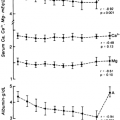PULSATILE GONADOTROPIN-RELEASING HORMONE
Part of “CHAPTER 97 – OVULATION INDUCTION“
Native GnRH is a decapeptide that is produced in the mediobasal and anterior hypothalamus and is transported via the portal vessels to the anterior pituitary to activate the secretion of the gonadotropins FSH and LH. When exogenous GnRH is administered in a pulsatile fashion, gonadotropin levels increase, causing ovarian stimulation.22 If GnRH is given in a continuous manner, an initial stimulatory response is noted; later, FSH and LH secretion are suppressed, resulting in hypoestrogenism because of receptor down-regulation and desensitization.
Patients with HA (WHO type I), who are hypoestrogenic secondary to diminished GnRH release, respond to intravenous (IV) or subcutaneous (SC) GnRH administered in a pulsatile fashion via a pump.23 The pumps used for ovulation induction generally are modified insulin pumps that allow a pulse frequency of 60 to 120 minutes with GnRH doses of 1 to 200 μg per pulse. The optimal IV dose is from 1 to 5 μg per pulse, whereas the equivalent dose given SC is 10 to 25 μg per pulse. When the proper dosage is achieved, 80% to 100% of HA patients ovulate, with a conception rate of 25% per treatment cycle. Although monofollicular development is most common with the use of the GnRH pump, when the amount of GnRH is increased, multiple follicles can be produced.24
Stay updated, free articles. Join our Telegram channel

Full access? Get Clinical Tree





